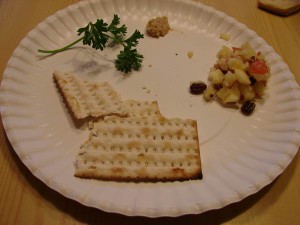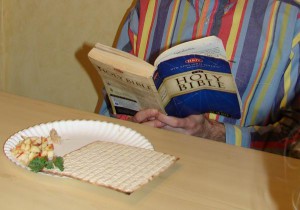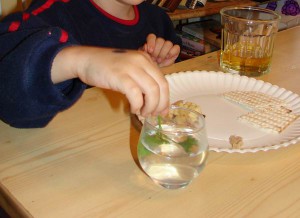{reposted from last year}
If you have small children and/or are overwhelmed with life and its responsibilities, feel free to skip right over this. I don’t want you to feel like it’s one more thing on the list of things to do. Our family chooses not do some other traditionally Easter activities, like visiting the Easter Bunny at the mall, or elaborate Easter Egg hunts, so that we (I) have time and energy for things like this.
I dug into the whole subject one year and was fascinated by the seven Jewish feasts and their symbolism of Christ. If you want more background on them, and why they matter to Christians, along with a more traditional (and complicated) Seder dinner,
here’s a document on the Background of Jewish Festivals and a Passover Seder for Older Kids. I typed it up several years ago when I apparently had lots of
time on my hands.
Now that I have three kids and very little time, I keep this document (the steps below) in my spring box in the pantry with the Resurrection Eggs, and I follow it word for word (since I’ve forgotten everything from the year before), and it still works. I have to say, I recommend this way. (We’ll try to do this tonight or Saturday night. These pictures are from several years ago.)
This whole meal is called the Passover Seder. Jesus celebrated the Passover with his disciples on the Thursday before he died. When your kids read that, they will now
understand what it means. It also important to note that Jesus died at the exact
same hour as the Passover lamb was killed. What are the chances of all the
days of the year, that he would be crucified that exact hour? And Jesus is
called our Passover Lamb. Coincidence? I think not.
Buy at the store:
- matzoh crackers (usually there is a Jewish display around now, with all the kosher food). These are crackers without leaven. They’re good!
- horseradish, the smallest jar possible (refrigerated, by the cheeses or deli area)
- parsley (produce section, by the lettuce probably)
- apples (2), walnuts or raisins, honey
- juice -white or (more symbolic, but potentially messier) red, grape juice
(Note: This year I forgot to buy grape juice, so we’ll use apple juice.) - You’ll also need: salt and water (you probably have these!)
Preparation:
- Chop up the apple, mix with honey and raisins or walnuts to form a sweet mixture.
- On everyone’s plate put a little piece of parsley, a small dab of horseradish, three pieces of matzoh crackers, and a spoonful of the apple mixture. Give everyone a glass of juice. Mix up a cup with water and salt, enough salt so it tastes salty. You can just have one for the table.

- From top: horseradish, Charoset (apple mixture), Matzoh (unleavened bread), parsley.
1. Gather the
family around, light a candle to show the feast has begun.
2. Read Old Testament. Have
the husband (if he’s there) read Exodus 12:3-14, 17 and 21-27. Or just retell the story of the final plague, that “the Israelites were in slavery, God was going to deliver them. They had to kill a perfect, spotless lamb, spread the blood around their door with hyssop branches, and eat unleavened bread because they were in a hurry and didn’t have time for the
yeast to rise. So, they did this, God’s Angel of Death PASSED OVER their houses
and their sons were saved. Then he brought them out of Egypt and saved them.
Who saves us? That’s right Jesus. Jesus is sometimes called the Passover Lamb.”

 2. Read New Testament – “So the Israelites kept having this Passover meal every year to remember how God saved them. Did you know Jesus celebrated the Passover with his disciples right before he died?” Read Luke 22:1-22 or summarize. We’re going to celebrate this Passover meal just like Jesus did.
2. Read New Testament – “So the Israelites kept having this Passover meal every year to remember how God saved them. Did you know Jesus celebrated the Passover with his disciples right before he died?” Read Luke 22:1-22 or summarize. We’re going to celebrate this Passover meal just like Jesus did.
3. Parsley & Saltwater (Hyssop & tears) – “First the parsley reminds us of the hyssop they dipped in the blood and put above the doors. The saltwater reminds us of the bitter tears they cried in Egypt and how hard slavery was. Everyone, get your parsley and dip it in the saltwater, and pretend to brush it
across the top and sides of your door. Now eat the parsley.”
4. Matzoh (Unleavened Bread)
- The leader (your husband or you) holds up the bread, explaining, “This
is to remind us of how they had to eat unleavened bread, because they were in
too much of a hurry to let the yeast rise. I will now break it into three pieces,
wrap it in a napkin (or linen cloth) and put it under my plate. We will come
back to this later.”
5. Horseradish
(“Maror” in Hebrew, bitter herbs) – next, the horseradish reminds us
of the bitter herbs the Isrealites had to eat with their meal. It reminds
us of how bitter their lives were in slavery. Dip a small (very very tiny, it’s
spicy) piece of your matzoh bread into the bitter herbs and taste it. (They can
spit it back out if they want. Have juice ready.)
6. Apple mixture (“Charoset” in Hebrew) – Now, this one tastes good! This mixture is
sweet. It reminds us of how sweet God’s love for them was to bring them out of
slavery. It also reminds us of the mortar they used to put in between the
bricks when they were slaves. You can dip your matzoh cracker in that and
eat it. God’s love for us is sweet, isn’t it?
7. Grape juice (wine, symbolic of Christ’s blood) – re-read the part in Luke where Jesus said, this is my blood, shed for you. This reminds us of how Jesus loved us so much
he died for us. You can drink some.
8. Unleavened Bread (again) - Take out the matzoh from under the plate. Jesus took the bread and broke it, just like I did, and gave it to his disciples saying, “This is my body, broken for you”. So, let’s eat a bite and remember how Jesus gave his body
for us. Now, notice how this bread is striped and pierced. Jesus was
whipped and nailed to the cross, so the bread reminds us of his body that was
also (striped and pierced). And there are three pieces, just like the Father,
Son and Holy Spirit. Also, Jesus was wrapped in a linen cloth and put in the
tomb, just like I wrapped this bread and put it under my plate. But then, what
happened? That’s right, he rose from the dead! So we can celebrate that he’s
Alive!
9. Finish the story – So, Jesus finished this ‘Last Supper’ with his disciples on Thursday night, then prayed in the garden of Gethsemane, then Judas betrayed him, then he died at the same time as the Passover Lamb died in the temple of Jerusalem on Friday. Isn’t that amazing, the one day, the one hour of the year that the Passover Lamb died, Jesus also died. That’s another proof that he’s our Passover Lamb. He saves us from our sins, just like God saved the Israelites from Egypt. Read I Cor 5:7 (Jesus is our Passover [Lamb]) After 3 days (Friday night, Saturday, Sunday
morning) he rose from the tomb.
You could eat a regular dinner now (or one without any yeast/leaven if you want to be
traditional) and talk about the Resurrection, letting each child open a colored
egg and retelling the story of Jesus’s Death and Resurrection. A soup dinner would work well because you could dip the crackers (unleavened bread in it). I think traditionally it’s a lamb stew, but we only did that one year. This flows in the story right after the Passover, so it fits perfectly to do those eggs next. Just talk about it
while you eat dinner.
Then, finish up with the first verse of “Christ the Lord is Risen Today”.
Christ the Lord is risen today, Alleluia!
Earth and heaven in chorus say, Alleluia!
Raise your joys and triumphs high, Alleluia!
Sing, ye heavens, and earth reply, Alleluia!
Now, when your children read about the Passover Feast, and later, take communion at church, they will know the history of it a little more.
Here’s a version of the Seder from the Focus on the Family magazine. I would say it’s medium-complicated. So maybe start with the simple one above if you have young kids, then graduate to the Focus on the Family one.
Please let me know if you try this, or if you already do it, and how it goes!

I am going to print this out and try it next year. Thanks!
Thanks Ana!